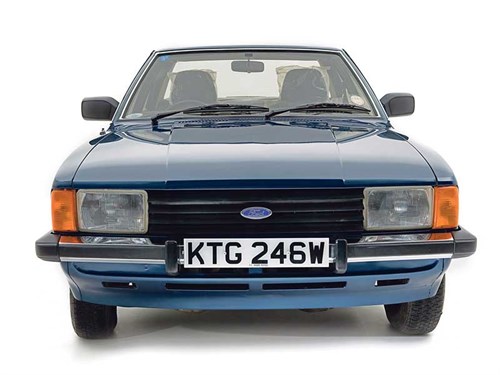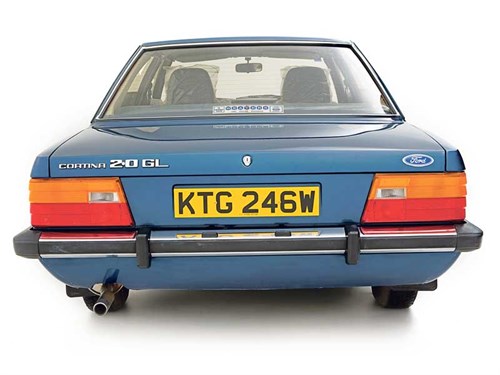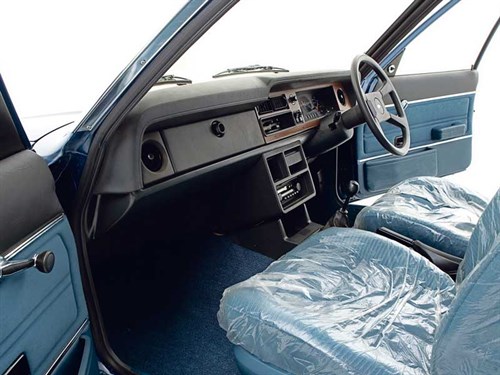The last of the line, the Cortina 80 would herald the end for one of the most popular cars in British history...

The Cortina was never a sports car, but it can still be a real hoot to drive. The 2.3-litre V6 is comfortably the best performer, being the largest capacity and highest power output of all Cortinas. The four-speed manual gearbox helps to make things feel quite sporty, urgently pulling through the gears when given enough encouragement.
Still a big car, it won’t appreciate being flung into corners, but suspension and brakes are both up to the task of relatively enthusiastic driving. Being particularly roomy inside, the MkV makes a perfect long distance tourer, and will be much more reliable than many older classics of similar type. A 0-60 time of only 10.5 seconds is ample to keep up with most modern traffic, and the top speed of 108mph is more than you would ever need on public roads. 1.6-litre and 2-litre cars are functional and will be suitable for most people, but the 1.3-litre version will leave you wanting much more.
VITAL STATISTICS
1979 Ford Cortina mkv
Engine 2294cc/V6/OHV
Power (bhp@rpm) 108bhp@5000rpm
Torque (lb ft@rpm) 130lb ft@3000rpm
Top speed 108mph
0-60mph 10.5sec
Consumption 23mpg
WHAT TO LOOK FOR
BODYWORK & CHASSIS
Though better protected than earlier incarnations, the MkV is still vulnerable to rot, and will have suffered if not well cared for. Check all bodywork for signs of rust, especially around the wheel arches and wings. Replacements in good condition will be affordable, but difficult to find. Be wary of cars that have recently been re-sprayed, they may be covering sub-standard repairs that will only begin to show when its too late. Take a small magnet with you when viewing to check suspected areas for signs of filler.
Lift the screen rubbers and inspect the metal below. If there is any sign of rot, avoid the car. If water has got in it will gradually be eating away the bulkhead, which will be prohibitively expensive to put right and potentially dangerous
if undetected.

ENGINE
Engine options fall into two types; Kent and Pinto. The smaller units were Kent engines, and should be good for around 100,000 miles or so. Anything more than this and you should be expecting a rebuild.
Check for any knocking noises, but don’t be too concerned by rattly tappets. Look for blue smoke under hard acceleration, burning oil is a sign of excessive engine wear.
Pinto engines, first used in the MkIII, require a cambelt change every 30,000 miles, so make sure this is documented. Regular oil changes are also
a must, so make sure the history is well documented and if possible, comprehensive.
2.3-litre Cologne V6s are the most durable of the bunch, and should outlast the car providing it is well cared for.

RUNNING GEAR
Suspension components are relatively cheap and easy to fix, but still carry out all the usual checks. Push down on each corner of the car, listening for any clunking or unusual noises. Check that the car sits at the same height on each corner. Sloppy handling and a shimmy from the rear are often signs of worn suspension bushes. Poly replacements will be a huge improvement, making the car much more predictable in the corners.
Four-speed gearboxes are very well put together and will likely cause you no real problems, but still check for the usual signs of wear and tear. Make sure it doesn’t jump out of gear, and that it is a smooth change with no strange noises or vibrations.
Some cars had five-speed Sierra boxes fitted; if this is the case make sure that the work is carried out to a high standard.
INTERIOR
Lift the carpets to inspect the floor pan, especially in the foot wells and seatbelt mounts. Foot wells are prone to rust, particularly in cars where the scuttle is also compromised. Lift the carpet in the boot and check for signs of rust and poorly welded patches. Take a good look at the sunroof, too. They leak in a variety of places, and any rot will likely be the tip of the iceberg.

OUR VERDICT
Brought in as an update to the Cortina MkIV, the Cortina 80, or MkV as it would become known, was produced at Ford’s assembly plant in Dagenham. A £30million facelift of its predecessor, the MkV – built for just three years between 1979 and 1982 – incorporated a number of improvements over the older design including larger indicators, greater glass area and revised rear lights.
There were also advances in aerodynamics, the Mk V getting a flatter, more streamlined roof, and wider front grille. Electronic ignition was added to top spec models, giving the 2.3-litre V6 variant a further 8bhp over the outgoing model. For the first two years the Cortina would become the best selling car in Britain, before eventually giving way to the Ford Escort in 1982.
More robust than previous models, the MkV is easier to maintain and much more affordable to purchase. Visibility and drivability are a vast improvement on the outgoing model.
There are few budget classics where your money will go quite as far as with a Cortina MkV. They’re getting thin on the ground these days, especially in good condition. Remarkably, this hasn’t affected values in the slightest; they’re still cheap as chips. Hold out for the top spec 2.3-litre Ghia model, and only part with your cash for a top rate example. You should be able to pick up a nice car for £1500, but don’t pay more than £2500. Most were consigned to the scrap heap many years ago, however cosseted examples are still available. There aren’t many more affordable routes to classic car ownership, and its rarity ensures you’ll cut a dash at any of the summer classic shows.